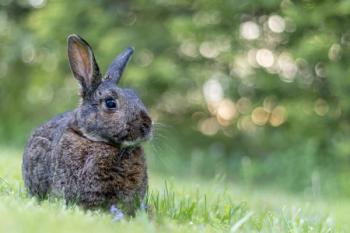
- dvm360 June 2022
- Volume 53
- Issue 6
- Pages: 32
Cultivating the colon: Probiotics and prebiotics
The fertile gut of a dog or cat brims with benevolent bacteria. Various forces can ravage this delicate population, but these microorganisms can be reestablished
The robust gastrointestinal tract—human, equine, feline, or canine—hosts a variety of microorganisms, including bacteria, viruses, fungi, and protozoa. These play a central role in maintaining the health and well-being of their host. In dogs, several hundred bacteria families populate the gut microbiome, but 99% of them belong to one of 5 main groups: Bacteroides, Firmicutes, Fusobacteria, Proteobacteria, or Actinobacteria.1
In kittens and puppies, this community of bugs begins forming even before young cats and dogs exit the birth canal and expands from there.2 Research shows puppies have a unique microbiome during their first few weeks of life, which is when Proteobacteria reigns. Change sets in by age 9 weeks, as Proteobacteria numbers drop to give way to Faecalibacterium species and Clostridium hiranonis. An adult dog’s environment, including other household members,3 can impact its gut microbiome, which becomes stable over time.4
Bacteria groups vary with geography along the intestines. The small intestine houses a mix of aerobes and facultative anaerobes, whereas the colon harbors anaerobes almost exclusively.5 In healthy dogs,6 the total bacterial load ranges between 1012 and 1014, with higher numbers in the colon than in the small intestine.1,6,7
The gut microbiota outcompetes pathogens, fuels the immune system,8 directs metabolic functions involved in health metrics (eg, weight control),9,10 and has other broad-ranging physiologic effects in the body.11 For instance, altered intestinal microbiota have been linked to chronic kidney disease,8 and populations of Streptococcus and Lactobacillus have been correlated with the insulin sensitivity index, suggesting a relationship between the intestinal colonies and insulin response.8,12
Studies have also connected joint stability, energy levels, and mood to gut health.8 A “gut-brain axis” revolves around neurotransmitter production: Serotonin originates primarily in the intestines13,14 and its assembly is partially controlled by resident bacteria. These microorganisms also manufacture the neurotransmitter, γ-aminobutyric acid.
However, the major job of the microbiome is to process nutrients in the gut, and the key players vary between carnivores and omnivores. The cat, for instance, relies more on Eubacteriaceae and Peptostreptococcaceae to digest crude protein.15 For the dog, however, crude protein digestibility is strongly hitched to Clostridiaceae. One particular species, C hiranonis, converts primary bile acids into secondary bile acids,16 which have local and systemic anti-inflammatory effects, suppress potential enteropathogens (eg, Clostridiodes difficile, Clostridium perfringens, and Escherichia coli), and activate receptors in other organ systems.17
In omnivores like the dog, who must also process carbohydrates, Bifidobacteriaceae, Lactobacillaceae, and Faecalibacteriaceae produce carbohydrate fermentation products that are converted into the short-chain fatty acid (SCFA), butyrate, which is the preferred energy source of colonocytes.4, 18-20 So too, different diets etch their own unique microbial stamps on the gut.19 For instance, Peptostreptococcaceae have been found to flourish in greater abundance in cats fed canned food than in those on kibbled diets. Likewise, Megasphaera and Blautia were shown to be more prevalent in those on kibbled vs canned meals.21
Rocking the bacteria boat
The gastrointestinal microbiome mirrors the overall wellness of an animal. Although stable in health, this community of microorganisms can be jolted by age, diet, environmental factors, and disease states. These shifts can result in gut dysbiosis, which is defined as alterations in the microbiota that result in functional changes in bacteria numbers, bacteria diversity, and metabolites. Dysbiosis leads to bile acid dysmetabolism and the intestinal inflammation that follows.
“Dysbiosis is a marker of underlying disease processes,” said Jan Suchodolski, MedVet, DrVetMed, PhD, DACVM, professor and associate director of the Gastrointestinal Laboratory at Texas A&M University in College Station. Suchodolski and his colleagues developed a Dysbiosis Index (DI) for dogs in 2017,2 as well as for cats just recently. This polymerase chain reaction–based assay quantifies the abundance of 7 bacterial groups and enables veterinarians to flag any changes in the composition of an animal’s fecal microbiota. The higher the DI—which is a better marker for characterizing chronic vs acute diarrhea—the greater the departure from the normal bacteria profile and the more protracted the malabsorption. “Severe dysbiosis is a negative predictor for being sick for a long time,” he said.
However, sickness isn’t limited to diarrhea. Recent work has tied dysbiosis with metabolic diseases, obesity, autoimmune maladies, cancer, and neurologic dysfunction in both dogs and humans.9-11,22 In dogs, dysbiosis is commonly marked by spikes in the number of facultative anaerobes of the Enterobacteriaceae family.23 This disproportion has various underlying factors.
Diversity of gastrointestinal microbes in many animals was found to drop with age. For example, older cats are prone to microbiome alterations that are thought to slow gastrointestinal transit time and lower nutrient digestibility. One study revealed a rise in Faecalibacterium species in cats at aged 5 years, and another showed a fall in these species in cats over aged 10 years.24-26
Proton pump inhibitors (ie, omeprazole), antibiotics, and chronic or acute stress (such as seen in kennel boarding) can also throw the gut into micro- bial imbalance. Broad-spectrum antibiotics often cause rapid and deep drops in taxonomic richness and balance that are rarely restored to their initial composition even after drug discontinuation.23,27
The main assault on the gut microbiome is gastrointestinal dysfunction. Both acute and chronic diarrhea interrupt the normal flora, chipping away at SCFA-producing bacteria.28 This can begin a continuous loop, as these shifts in bacteria taxa compound intestinal inflammation that culminates in architectural changes such as villous atrophy, which produce more diarrhea and further efflux of healthy bugs.23 Dogs with acute diarrhea and hemorrhagic gastroenteritis have been shown to have reduced numbers of the beneficial bacteria (Ruminococcaceae and Faecalibacterium), enabling the pathogenic bacteria (C perfringens) to take up residence.7,29
Probiotics to the rescue
Probiotics are exogenous sources of live microorganisms that inoculate the intestines with good bacteria and yeasts, which crowd out the pathogenic bacteria. These beneficial floras produce SCFAs and antimicrobial metabolites, or bacteriocins, that enhance functionality of the epithelial barrier and modulate the immune response.
The primary groups included in probiotics for cats and dogs are lactic acid bacteria, particularly lactobacilli, bifidobacteria, and enterococci. They ferment sugars into organic acids that lower the gut pH and inhibit the growth of pathogenic bacteria.
Probiotics have made some impressive rescues, according to studies.30 One strain of Enterococcus faecium sped recovery in diarrheic shelter cats, improved diarrhea in owned cats, and enhanced stool quality in cats with intractable diarrhea. In dogs, this strain improved the benefits of metronidazole alone in decreasing the prevalence of diarrhea. Additionally, a multistrain probiotic eased clinical signs in dogs with inflammatory bowel disease (IBD).31
In a study of dogs with IBD, those receiving a probiotic had not only increased numbers of healthy bacteria in adherent mucus but also demonstrated better tight junction protein expression, suggesting favorable effects on mucus homeostasis in the intestines. Another trial found a multistrain probiotic to be a successful alternative to treatment with a combination protocol of metronidazole/prednisone in dogs with IBD.32 Probiotics don’t just shut the fecal fountain; they have also been shown to ameliorate feline constipation, which, in some cases, stems from colonic microflora imbalances.
Because the common triggers of acute diarrhea are well established, probiotics can be used to prevent or minimize diarrhea when administered preemptive to stressful events. If probiotics are given prior to, for example, kenneling, car travel, or even planned food changes, Suchodolski recommends starting the regimen a week before such events as it takes a few days for the probiotic bacteria to colonize.
When antibiotics must be given for an unrelated condition, animals can also benefit from simultaneous administration of a probiotic. This especially applies to cats, because the feline gastrointestinal tract is particularly sensitive to antibiotics, Suchodolski noted.
Canine gut health has an added interplay between microflora and gastrointestinal sensitivity. Because the intestinal scaffolding for the microbiome is smaller, relatively speaking, for large dogs vs small dogs (approximately 2% vs 7%), the former are more prone to developing loose stool.
However, Suchodolski does not recommend routine use of probiotics in healthy animals. Research shows probiotic bacteria are generally unable to colonize the gut well because of competition from a sturdy and well-established microbiome in these animals. For acute diarrhea, a probiotic treatment duration of 7 to 14 days is usually sufficient, but chronic disease may require many months of probiotic therapy, Suchodolski explained.
Probiotic choices
To function as a viable probiotic, the bacteria—suspended in a state of hibernation within capsules, powders, and pastes—must be able to survive the acid and bile found in the gastrointestinal tract, adhere to the intestinal cells, and coaggregate to achieve balanced microflora populations. It must also be safe, noninvasive, noncarcinogenic, and nonpathogenic.33
As nutraceuticals, probiotics are less regulated than medications and often contain a single strain of bacteria. For example, Purina’s FortiFlora consists of E faecium strain SF68. Iams’ Prostora, which has been discontinued, contained Bifidobacterium animalis strain AHC7. Nutramax Laboratories’ Proviable, available in both capsules and paste for dogs and cats, uses 7 types of bacteria, in keeping with the idea that individual animals—even puppies within the same litter—have a slightly unique set of gut microbiota. Likewise, Visbiome Vet (ExeGi Pharma) contains 8 unique bacterial strains.
Probiotic concentration is measured in colony-forming units (CFUs) and, generally speaking, patients should receive 1 billion to 10 billion CFUs daily. Probiotic formulations also contain yeasts and other enzymes, vitamins, and minerals. However, their live content restricts shelf life to a few months, so quality control is extremely important.
Prebiotic nutrients
These new colonies of probiotic organisms thrive on high-fiber diets that are rich in fruits and vegetables. Soluble fiber, which Mother Nature packages in foods such as sweet potatoes, oats, asparagus, apples, barley, soybeans, chicory root, and pumpkin, is commercially available as prebiotics.20
Prebiotics contain minimally digestible complex carbs called oligosaccharides, which are fermented by the gut bacteria to produce nutritive SCFAs. The soluble fiber in prebiotics also aids in treating and preventing diarrhea by absorbing moisture, thereby slowing intestinal movement and preventing spikes in blood sugar.
Another advantage of prebiotics is their ability to alter gut pH and their healing effect on the intestines, both of which enhance absorption of minerals such as calcium.
As a food source for the microbiome, prebiotics are a useful additive to probiotic therapy. Veterinary prebiotic-probiotic combos, known as synbiotics,34 are available in different formulations, including FortiFlora SA Synbiotic Action and Proviable Kits that consist of prebiotic paste and probiotic capsules.
Although prebiotics and probiotics are beneficial on their own and can be given by themselves, every therapy should be evaluated on a case-by-case basis.
New horizons
Although a single dose of the most full-bodied probiotic offers over 7 bacterial strains in a quantity of billions, Suchodolski cautioned that probiotics are generally not enough to bring back the full microbiome. However, there is a newcomer that can deliver 100 different strains in concentrations that run 1000 times greater than even the densest probiotic.
This new therapy, fecal microbiota transplantation (FMT), is the transfer of stool from a healthy donor to the gut of a recipient in order to treat intestinal dysbiosis. For repopulating the gut, FMT far outpaces probiotics. “Why plant a rose bush in the jungle when you can replant the whole forest?” Suchodolski said.
Although FMT has a high success rate in treating humans infected with C difficile, it’s an emerging therapy in dogs and cats with few published studies. Recent data in dogs show that FMT may help restore C hiranonis numbers and bile acid metabolism, which is a particular boost for patients infected with C difficile or C perfringens.31,35,36 FMT also fast-tracked the resolution of diarrhea when added to the standard antimicrobial treatment protocol in puppies with parvovirus.37
FMT can be delivered by capsule or enema but it is now used by very few veterinary practices. Suchodolski and his colleagues have formed an FMT consortium to develop best practices. Although FMT is not the solution for every animal, he explained, it could help young animals with anti-biotic-induced dysbiosis and chronically ill animals who are only partially responsive to corticosteroids and diet changes. “In 5 years, every vet should know how to use FMT,” Suchodolski said.
Now what we know is this: The microbiome is as complex as it is delicate, so reversing dysbiosis often involves a multimodal approach. “When we consider antibiotics, probiotics, and fiber, it’s important to remember that each addresses different disease processes,” Suchodolski said.
Joan Capuzzi, VMD is a small animal veterinarian and journalist based in the Philadelphia, Pennsylvania area.
References
- Suchodolski JS. Intestinal microbiota of dogs and cats: a bigger world than we thought. Vet Clin North Am Small Anim Pract. 2011;41(2):261-272. doi:10.1016/j.cvsm.2010.12.006
- Cigarroa A, Suchodolski JS. Assessing the development of the postnatal canine gastrointestinal microbiome utilizing the dysbiosis index. Presented at: National Veterinary Scholars Symposium; August 4-8, 2018: College Station, TX.
- Song SJ, Lauber C, Costello EK, et al. Cohabiting family members share microbiota with one another and with their dogs. Elife. 2013;2:e00458. doi:10.7554/eLife.00458
- Garcia-Mazcorro JF, Dowd SE, Poulsen J, Steiner JM, Suchodolski JS. Abundance and short-term temporal variability of fecal microbiota in healthy dogs. Microbiologyopen. 2012;1(3):340-347. doi:10.1002/mbo3.36
- Mentula S, Harmoinen J, Heikkilä M, et al. Comparison between cultured small-intestinal and fecal microbiotas in beagle dogs. Appl Environ Microbiol. 2005;71(8):4169-4175. doi:10.1128/AEM.71.8.4169-4175.2005
- Honneffer JB, Steiner JM, Lidbury JA, Suchodolski JS. Variation of the microbiota and metabolome along the canine gastrointestinal tract. Metabolomics. 2017;13:26. doi:10.1007/s11306-017-1165-3
- Suchodolski JS, Camacho J, Steiner JM. Analysis of bacterial diversity in the canine duodenum, jejunum, ileum, and colon by comparative 16S rRNA gene analysis. FEMS Microbiol Ecol. 2008;66(3):567-578. doi:10.1111/j.1574-6941.2008.00521.x
- Tizard IR, Jones SW. The microbiota regulates immunity and immunologic diseases in dogs and cats. Vet Chin North Am Small Anim Tract. 2018;48(2):307-322. doi:10.1016/j.cvsm.2017.10.008
- Kieler IN, Shamzir Kamal S, Vitger AD, Nielsen DS, Lauridsen C, Bjornvad CR. Gut microbiota composition may relate to weight loss rate in obese pet dogs. Vet Med Sci. 2017;3(4):252-262. doi:10.1002/vms3.80
- Montoya-Alonso JA, Bautista-Castaño I, Peña C, Suárez L, Juste MC, Tvarijonaviciute A. Prevalence of canine obesity, obesity-related metabolic dysfunction, and relationship with owner obesity in an obesogenic region of Spain. Front Vet Sci. 2017;4:59. doi:10.3389/fvets.2017.00059
- Zitvogel L, Daillère R, Roberti MP, Routy B, Kroemer G. Anticancer effects of the microbiome and its products. Nat Rev Microbiol. 2017;15(8):465-478. doi:10.1038/nrmicro.2017.44
- Bell ET, Suchodolski JS, Isaiah A, et al. Faecal microbiota of cats with insulin-treated diabetes mellitus. PLoS One. 2014;9(10):e108729. doi:10.1371/journal.pone.0108729
- Hata T, Asano Y, Yoshihara K, et al. Regulation of gut luminal serotonin by commensal microbiota in mice. PLoS One. 2017;12(7):e0180745. doi:10.1371/journal.pone.0180745
- O’Mahony SM, Clarke G, Borre YE, Dinan TG, Cryan JF. Serotonin, tryptophan metabolism and the brain-gut-microbiome axis. Behav Brain Res. 2015;277:32-48. doi:10.1016/j.bbr.2014.07.027
- Hooda S, Vester Boler BM, Kerr KR, Dowd SE, Swanson KS. The gut microbiome of kittens is affected by dietary protein: carbohydrate ratio and associated with blood metabolite and hormone concentrations. Br J Nutr. 2013;109(9):1637-1646. doi:10.1017/S0007114512003479
- Rivera-Chávez F, Zhang LF, Faber F, et al. Depletion of butyrate-producing clostridia from the gut microbiota drives an aerobic luminal expansion of salmonella. Cell Host Microbe. 2016;19(4):443-454. doi:10.1016/j.chom.2016.03.004
- Bermingham EN, Maclean P, Thomas DG, Cave NJ, Young W. Key bacterial families (Clostridiaceae, Erysipelotrichaceae and Bacteroidaceae) are related to the digestion of protein and energy in dogs. PeerJ.2017;5:e3019. doi:10.7717/peerj.3019
- Turroni F, van Sinderen D, Ventura M. Genomics and ecological overview of the genus Bifidobacterium. Int J Food Microbiol. 2011;149(1):37-44. doi:10.1016/j.ijfoodmicro.2010.12.010
- Vital M, Gao J, Rizzo M, Harrison T, Tiedje JM. Diet is a major factor governing the fecal butyrate-producing community structure across Mammalia, Aves and Reptilia. ISME J. 2015;9(4):832-843. doi:10.1038/ismej.2014.179
- Wang S, Martins R, Sullivan MC, et al. Diet-induced remission in chronic enteropathy is associated with altered microbial community structure and synthesis of secondary bile acids. Microbiome. 2019;7(1):126. doi:10.1186/s40168-019-0740-4
- Birmingham EN, Young W, Butowski CF, et al. The fecal microbiota in the domestic cat (Felis catus) is influenced by interactions between age and diet; a five year longitudinal study. Front Microbiol. 2018;9:1231. doi:10.3389/fmicb.2018.01231
- Wu J, Zhang Y, Yang H, Rao Y, Miao J, Lu X. Intestinal microbiota as an alternative therapeutic target for epilepsy. Can J Infect Dis Med Microbiol. 2016;2016:9032809. doi:10.1155/2016/9032809
- Zeng MY, Inohara N, Nuñez G. Mechanisms of inflammation-driven bacterial dysbiosis in the gut. Mucosal Immunol. 2017;10(1):18-26. doi:10.1038/mi.2016.75
- Fischer MM, Kessler AM, Kieffer DA, et al. Effects of obesity, energy restriction and neutering on the faecal microbiota of cats. Br J Nutr.2017;118(7):513-524. doi:10.1017/S0007114517002379
- O’Toole PW, Jeffery IB. Gut microbiota and aging. Science.2015;350(6265):1214-1215. doi:10.1126/science.aac8469
- Peachey SE, Dawson JM, Harper EJ. The effect of ageing on nutrient digestibility by cats fed beef tallow-, sunflower oil- or olive oil-enriched diets. Growth Dev Aging. 1999;63(1-2):61-70.
- Reese AT, Cho EH, Klitzman B, et al. Antibiotic-induced changes in the microbiota disrupt redox dynamics in the gut. Elife. 2018;7:e35987. doi:10.7554/eLife.35987
- Giaretta PR, Rech RR, Guard BC, et al. Comparison of intestinal expression of the apical sodium-dependent bile acid transporter between dogs with and without chronic inflammatory enteropathy. J Vet Intern Med. 2018;32(6):1918-1926. doi:10.1111/jvim.15332
- Unterer S, Busch K, Leipig M, et al. Endoscopically visualized lesions, histologic findings, and bacterial invasion in the gastrointestinal mucosa of dogs with acute hemorrhagic diarrhea syndrome. J Vet Intern Med.2014;28(1):52-58. doi:10.1111/jvim.12236
- Bybee SN, Scorza AV, Lappin MR. Effect of the probiotic Enterococcus faecium SF68 on presence of diarrhea in cats and dogs housed in an animal shelter. J Vet Intern Med. 2011;25(4):856-860. doi:10.1111/j.1939-1676.2011.0738.x
- White R, Atherly T, Guard B, et al. Randomized, controlled trial evaluating the effect of multi-strain probiotic on the mucosal microbiota in canine idiopathic inflammatory bowel disease. Gut Microbes.2017;8(5):451-466. doi:10.1080/19490976.2017.1334754
- Rossi G, Pengo G, Caldin M, et al. Comparison of microbiological, histological, and immunomodulatory parameters in response to treatment with either combination therapy with prednisone and metronidazole or probiotic VSL#3 strains in dogs with idiopathic inflammatory bowel disease. PLoS One. 2014;9(4):e94699. doi:10.1371/journal.pone.0094699
- Heinze CR. Good bugs/bad bugs—the confusing world of probiotic supplements. Petfoodology blog. June 12, 2017. Accessed May 24, 2022.
vetnutrition.tufts.edu/2017/06/probiotics . - Garcia-Mazcorro JF, Lanerie DJ, Dowd SE, et al. Effect of a multi-species synbiotic formulation on fecal bacterial microbiota of healthy cats and dogs as evaluated by pyrosequencing. FEMS Microbiol Ecol. 2011;78(3):542-554. doi:10.1111/j.1574-6941.2011.01185.x
- Chaitman J, Ziese AL, Pilla R, et al. Fecal microbial and metabolic profiles in dogs with acute diarrhea receiving either fecal microbiota transplantation or oral metronidazole. Front Vet Sci. 2020;7:192. doi:10.3389/fvets.2020.00192
- Weingarden AR, Chen C, Bobr A, et al. Microbiota transplantation restores normal fecal bile acid composition in recurrent Clostridium difficile infection. Am J Physiol.2014;306(4):G310-319. doi:10.1152/ajpgi.00282.2013
- Pereira GQ, Gomes LA, Santos IS, Alfieri AF, Weese JS, Costa MC. Fecal microbiota transplantation in puppies with canine parvovirus infection. J Vet Intern Med.2018;32(2):707-711. doi:10.1111/jvim.15072
Articles in this issue
over 3 years ago
Taking Pride in Yourself and Othersover 3 years ago
Coenzyme Q10 use in petsover 3 years ago
Where’s the money?over 3 years ago
“Hello, I Must Be Going”: Groucho joins the familyover 3 years ago
Advanced laser surgery, and digital cytology elevate pet careover 3 years ago
Iatrogenic hypothyroidism in catsover 3 years ago
Talking pride in the veterinary professionover 3 years ago
An overview of critical care fluid therapy typesNewsletter
From exam room tips to practice management insights, get trusted veterinary news delivered straight to your inbox—subscribe to dvm360.






